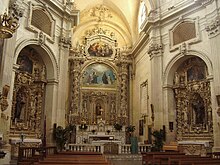Giuseppe Cino
Giuseppe Cino (born June 15, 1645 in Lecce ; † April 1722 there ) was an Italian builder and chronicler. Coming from a noble family, Cino, who called himself “ingegnere”, contributed to the spread of the Baroque in Apulia with its center in Lecce. In doing so, he produced a mixture of Roman-inspired monumentality and Spanish decorative art.
Lecce was a much more important city in the 17th century than it is today. While Otranto fell into disrepair as a regional metropolis since the 16th century, Lecce became a center of baroque art. The later Pope Innocent XII. was Antonio Pignatelli Bishop of Lecce from 1671 to 1673, Pope from 1691 to 1700.
Life
Giuseppe Cino was one of five sons of Ferrante Cino and his wife Domenica De Donni. He probably went into business for himself because he was always referred to as "Maestro", but there are no records. Cino first learned from Giuseppe Zimbalo , who had a monopoly over all monumental buildings in Lecce. There Zimbalo drafted a plan for the reconstruction of the Chiesa di S. Chiara , the Santa Chiara Church, which had existed since the 15th century . The renovation began in 1678. Cino took over the work on this church from 1687 to 1701. The work was actually supposed to be completed in 1691, but the Carmelites also used the church during this time.
He also worked on the Church of Madonna del Carmine from 1714 to 1717, but the church was only completed after his death by Mauro Manieri , as well as on the Chiesa delle Alcantarine in Lecce. In doing so, Cino turned out to be more monumental, but also more filigree and organic in his work than his teacher was.
At that time, Spain was the dominant power in southern Italy, but after the death of the last Habsburg from 1701, the War of the Spanish Succession broke out . In the Treaty of Utrecht in 1713, Milan , Naples (excluding Sicily) and Sardinia, previously Spanish , were granted to Austria . It thus became the dominant power in Italy.
Lecce, the idiosyncratic center of the southern Italian baroque, was in no way harmed by these fierce battles. Cino followed Zimbalo as a builder at the Palazzo dei Celestini .
According to plans by Giuseppe Cino, at the request of Bishop Michele Pignatelli, the Lecce seminary was built between 1694 and 1709 , while the great powers fought over the inheritance of the Spanish Habsburgs . The Chiesa di Sant'Anna (1683–1699) in Mesagne ( Brindisi province ) is also attributed to him. Finally, in 1704 he created an altar for the Carmine Church and in the following year for the Confraternità del Rosario in Martignano . In 1716 he worked on SS Nicola e Cataldo . A baroque facade was added to the 12th century church while retaining the original portals.
With his Memorie , Giuseppe Cino wrote a chronicle of Lecce for the period from 1656 to 1719, which, however, was not published until 1905/06. There he describes the earthquake of June 5, 1688.
timeline
- Memorie ossia notiziario di molte cose accadute in Lecce dall'anno 1656 sino all'anno 1719, dal signor Giuseppe Cino ingegnere leccese , in: A. Laporta (ed.): Cronache di Lecce , Lecce 1991, pp. 49-98.
literature
- Michele Paone: Per la storia del barocco leccese , in: Archivio Storico Pugliese 35 (1982) 139-183. ( online , PDF)
- Regina Poso: CINO, Giuseppe. In: Alberto M. Ghisalberti (Ed.): Dizionario Biografico degli Italiani (DBI). Volume 25: Chinzer – Cirni. Istituto della Enciclopedia Italiana, Rome 1981.
Web links
- Cino, Giuseppe. In: Enciclopedie on line. Istituto della Enciclopedia Italiana, Rome. Retrieved September 23, 2016.
Remarks
- ^ Timothy Verdon: L'arte cristiana in Italia. Età moderna e contemporanea , San Paolo, 2008, p. 36.
- ↑ Michele Paone, p. 140.
- ^ Ekkehart Rotter: Apulia . Trips to Byzantine grotto churches, Norman cathedrals, Hohenstaufen forts and baroque buildings in Lecce. (= DuMont art travel guide ). 6th edition. Dumont Reise Verlag, Ostfildern 2012, ISBN 3-7701-4314-0 . , P. 323.
- ↑ Francesco Abbate: Storia dell'arte nell'Italia meridionale , Volume 4, Donzelli Editore, Rome 2002, p. 269 f.
- ^ Rudolf Wittkower : Art and Architecture in Italy, 1600-1750 , Yale University Press, 1999, Vol. 3, p. 27.
- ^ Giorgio Bersano, Mariella Alicata: Italia. Guida artistica , Electa, Milano 1992, p. 831.
- ^ Giuseppe Cino: Memorie ossia notiziario di molte cose accadute in Lecce dall'anno 1656 sino all'anno 1719, dal signor Giuseppe Cino ingegnere leccese , in: Rivista storica salentina (1905-6) 62-130, edited by Pietro Palumbo , translation from 1847 by S. Castromediano.
- ^ Catalog of Strong Earthquakes in Italy 461 BC - 1997 and Mediterranean Area 760 BC - 1500 .
| personal data | |
|---|---|
| SURNAME | Cino, Giuseppe |
| BRIEF DESCRIPTION | Italian sculptor and builder |
| DATE OF BIRTH | June 15, 1645 |
| PLACE OF BIRTH | Lecce |
| DATE OF DEATH | April 1722 |
| Place of death | Lecce |



